#solid rocket boosters
Note
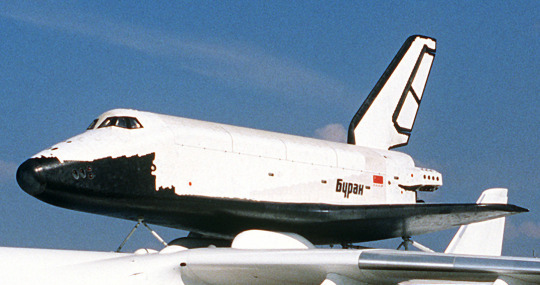
Roscosmos Space Shuttle 1K 1.01 Buran (Snowstorm)
Antonov An-225 Mriya (Dream)
#I'm so upset that both these vehicles have been destroyed#first the Buran when it's hangar roof collapsed at Baikonur due to years of neglect#and then the Mriya during the attack on Kyiv in 2022#there are incomplete examples of both which could in theory be finished with enough funding#but I don't have the money to do it#the Soviet space shuttle program was interesting#in several ways the Soviet design was superior to the American one#it's booster rocket - Energia - used kerosene and liquid oxygen as opposed to the solid rocket boosters of the US shuttle#this meant the engines could be shut down in an emergency#and you wouldn't have an accident like the one which destroyed Challenger#the Buran was also fully autonomous#it's first flight was uncrewed and it managed to land itself back on the runway after reentry#an impressive feat for the technology of the time#thanks for the ask!#roscosmos#buran#space shuttle
11 notes
·
View notes
Text
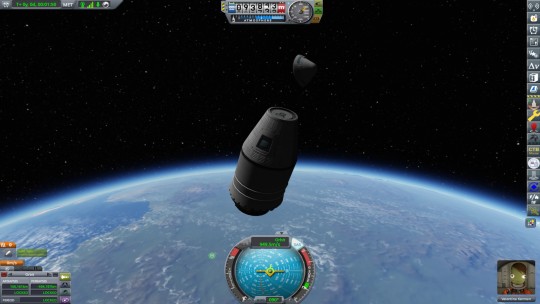
hey. i need that.
#if ur wondering how this happened:#i used the inline mystery goo module from some mod i can't remember#and then launched a rocket with a stack of solid boosters#which went so fast the mystery goo burned up before i reached space#and the parachute was attached#rip valentina#jeb already died#got a new pilot they died too#gonna restart this run#ksp#kerbal space program
0 notes
Text

Moonbound: One Year Since Artemis I
On this day last year, the Artemis I rocket and spacecraft lit up the sky and embarked on the revolutionary mission to the Moon and back. The first integrated flight test of the rocket and spacecraft continued for 25.5 days, validating NASA’s deep exploration systems and setting the stage for humanity’s return to the lunar surface.

On Nov. 16, 2022, the Space Launch System (SLS) rocket met or exceeded all expectations during its debut launch on Artemis I. The twin solid rocket booster motors responsible for producing more than 7 million pounds of thrust at liftoff reached their performance target, helping SLS and the Orion spacecraft reach a speed of about 4,000 mph in just over two minutes before the boosters separated.

Quite a few payloads caught a ride aboard the Orion spacecraft on the Artemis I mission: In addition to a number of small scientific satellites called CubeSats, a manikin named Commander Moonikin Campos sat in the commander’s seat. A Snoopy doll served as a zero-gravity indicator — something that floats inside the spacecraft to demonstrate microgravity.
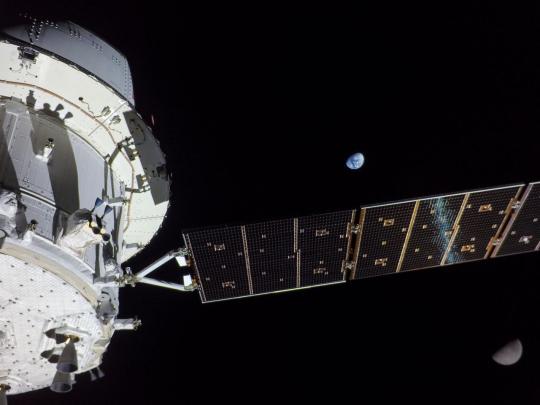
During the mission, Orion performed two lunar flybys, coming within 80 miles of the lunar surface. At its farthest distance during the mission, Orion traveled nearly 270,000 miles from our home planet, more than 1,000 times farther than where the International Space Station orbits Earth. This surpassed the record for distance traveled by a spacecraft designed to carry humans, previously set during Apollo 13.
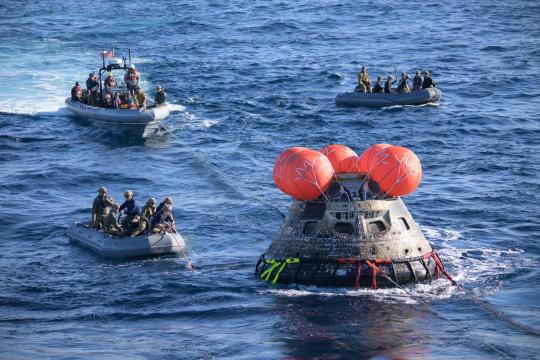
The Orion spacecraft arrived back home to planet Earth on Dec. 11, 2022. During re-entry, Orion endured temperatures about half as hot as the surface of the Sun at about 5,000 degrees Fahrenheit. Within about 20 minutes, Orion slowed from nearly 25,000 mph to about 20 mph for its parachute-assisted splashdown.
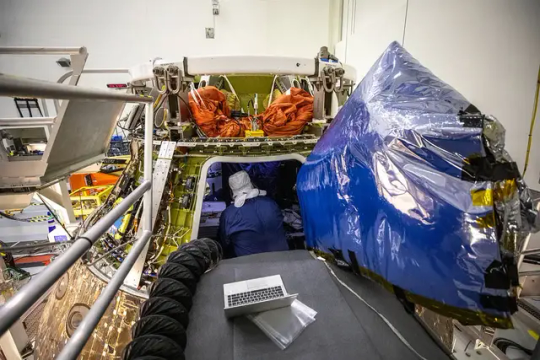
Recovery teams successfully retrieved the spacecraft and delivered it back to NASA’s Kennedy Space Center for de-servicing operations, which included removing the payloads (like Snoopy and Commander Moonikin Campos) and analyzing the heat shield.
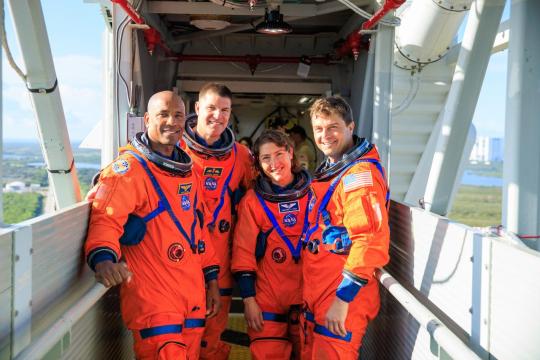
With the Artemis I mission under our belt, we look ahead to Artemis II — our first crewed mission to the Moon in over 50 years. Four astronauts will fly around the Moon inside Orion, practicing piloting the spacecraft and validating the spacecraft’s life support systems. The Artemis II crew includes: NASA astronauts Reid Wiseman, Victor Glover, and Christina Koch, and CSA astronaut Jeremy Hansen.
youtube
As we look ahead to Artemis II, we build upon the incredible success of the Artemis I mission and recognize the hard work and achievements of the entire Artemis team. Go Artemis!
Make sure to follow us on Tumblr for your regular dose of space!
#Artemis#Rocket#Anniversary#Launch#NASA#Space#Moon#Lunar#Astronaut#Apollo#Orion#Spacecraft#Space Launch System#STEM#science#tech#technology#on this day#Youtube
2K notes
·
View notes
Text
ISRO successfully tests large human-rated solid rocket booster for Gaganyaan mission
ISRO successfully tests large human-rated solid rocket booster for Gaganyaan mission
ISRO successfully tests large human-rated solid rocket booster for Gaganyaan mission
The HS200 is the human-rated version of the S200 rocket booster of satellite launch vehicle GSLV Mk III, popularly known as LVM3, the Bengaluru-headquartered space agency noted in a statement.
The HS200 is the human-rated version of the S200 rocket booster of satellite launch vehicle GSLV Mk III, popularly known…
View On WordPress
0 notes
Text

STS-45 Atlantis Launch
"With its twin solid rocket boosters and three main engines churning at seven million pounds of thrust, the Space Shuttle Atlantis thunders skyward from Launch Pad 39A. Liftoff of Mission STS-45 occurred at 8:13:40 a.m. EST, March 24, 1992. On board for the 46th Shuttle flight are a crew of seven and the Atmospheric Laboratory for Applications and Science-1 (ATLAS-1). The launch is the second in 1992 for the Shuttle program and Atlantis' 11th flight."
Date: March 24, 1992
NASA ID: 92PC-0644
#STS-45#Space Shuttle#Space Shuttle Atlantis#Atlantis#OV-104#Orbiter#NASA#Space Shuttle Program#launch#LC-39A#Kennedy Space Center#Florida#March#1992#my post
177 notes
·
View notes
Text
Jay = High Intelligence, Low Wisdom
Kai = Low Intelligence, High Wisdom
Essay about this concept below the cut
Now these are all just my interpretations of the characters, I don't necessarily have hard evidence on hand to back all this up, but here we go:
I've been trying to put my finger on the Kai smart/dumb duality, and I think I can finally somewhat make out my thoughts. Kai is not smart. Book smarts don't come easily to him, he's not great at math, he's not great at overly complex stratagizing- but he's got a LOT of great knowledge in him.
Take the dragon healing in DR. He might not intuitively know how different medicines work or why, but he's got injured enough that he knows that type of information is important to know, and so he's forced it into his head. He couldn't tell you why the blue goop helpped the dragon, but he knew that it would, and that it would be important to remember that it would.
He's pretty good at navigating complex social situations, because he's good at reading people. Having had a history with extreme emotions, he knows how to take them into account, and knows how important it is to do so, even if it's not necessarily logical. I hate to say this, but he's very emotionally intelligent, which sounds kinda like an insult but is actually insanely valuable, because humans are inherently emotional creatures.
He's got a solid basis of common sense, and is constantly looking at the bigger picture. That's why he can come up with the best outline for a plan, because he can not think through the details. Now, if he tries to implement a plan of his without consulting others, he's probably going to miss some very important details, and screw himself over. But, he's most likely to have the best basic premise for an effective plan. This is why his intuition is usually correct. He's not logically thinking through the most likely scenario given all available factors, he's looking at every problem from the birds eye view, and is easily able to fill in the blanks, because he sees the whole picture. You can not tell me this kid knew Lloyd was the Green Ninja because he used logical deduction to eliminate all other possibilities, he had a gut feeling based on realizing the value of human life.
Now, sometimes you need details. And Kai is not good at those. He sucks at those. Big time. But he's self aware enough to know when those times are (most of the time, sometimes he wastes all his lives in a video game before talking to anyone else).
The thing all of these points have in common is that he's lived a very full life while making very many mistakes, and he's learned from all of them. He learns from his dumb mistakes, and is wise enough to know which lessons are worth holding on to.
Jay on the other hand... does not learn from his mistakes. He's got a real thick skull.
Inside that skull is a really smart guy who intuitively latches on to engineering and science concepts. He's got a whole heck of a lot of information that his brain is holding onto simply because it can. This man is all about the details. He gets hyperfixated on details to the point where it's a problem. He's the most likely to solve the intricate problem facing the team, forget that they need to stay hidden, and yell "I did it!". Good at details, bad at big picture. This is also why he usually gives up hope so easily compared to the rest of the team. He can not think long term, he can not see the bigger picture like Kai can, so road blocks in the current plan seem insurmountable.
Sure, he might have rigged an old sailing ship with rocket boosters, but he couldn't unscramble "darnagom" his logical problem solving skills are not what's carrying him.
My standby for the Jay dumb/smart duality is that he should have a significant amount of William Osman energy to him. He's very smart, and can work out how to solve intricate problems and make insane builds, but if making said things is a dangerous or dumb idea has never once crossed his mind, and if it has, he has actively chosen to ignore it. Jay's intelligence is much more creativity based than I think a lot of people like to think. Engineering is about slapping crazy ideas together which barely hold together at first- and that's Jay's brand of smarts.
If you compare this to Zane, that's the vital component that his intelligence is missing- the creativity. He is VERY good at assessing options, but not so great at coming up with new solutions himself. He's running on pure logic and tested successes. He's also missing that social intelligence that Kai has. I'd venture to say that Zane is, by far the most gullible member of the team. If there is not a solid logical reason to doubt something, he is absolutely going to take it at face value. Point being, all the ninja have different smarts, and stupidities, let's not try to conflate them too much.
#ninjago#dragons rising#long post#parachuterants#jay walker#kai smith#zane julien#jay ninjago#kai ninjago#I'm sure someone has mapped out them all as D&D characters by now#that's what I'm leaning towards#cole is the dumbest for the record#a lot of his points are in strength
143 notes
·
View notes
Text
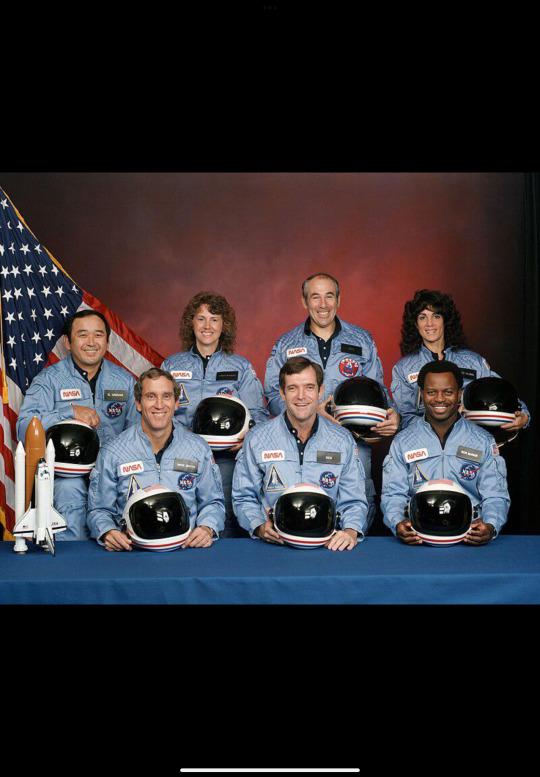



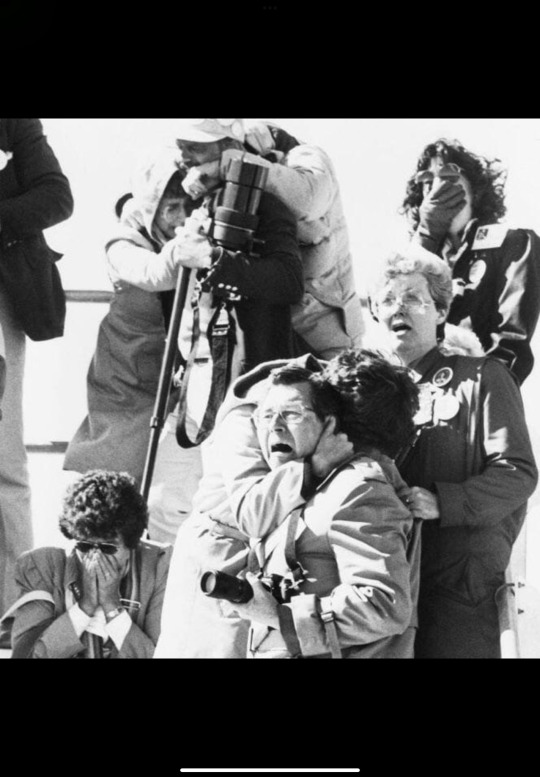
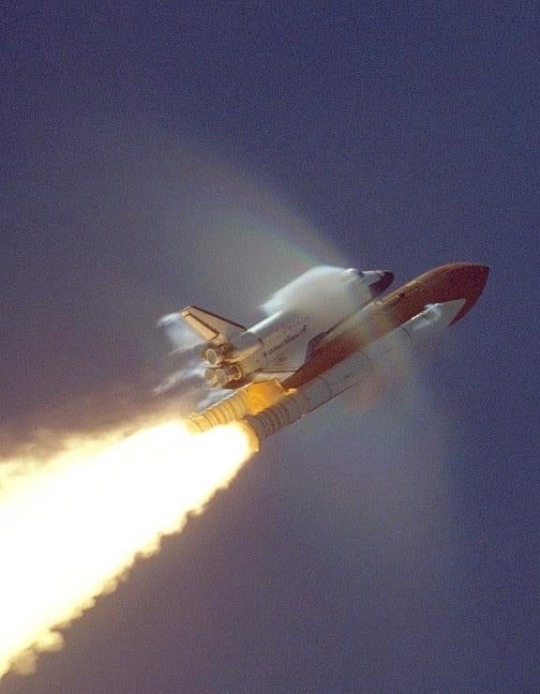
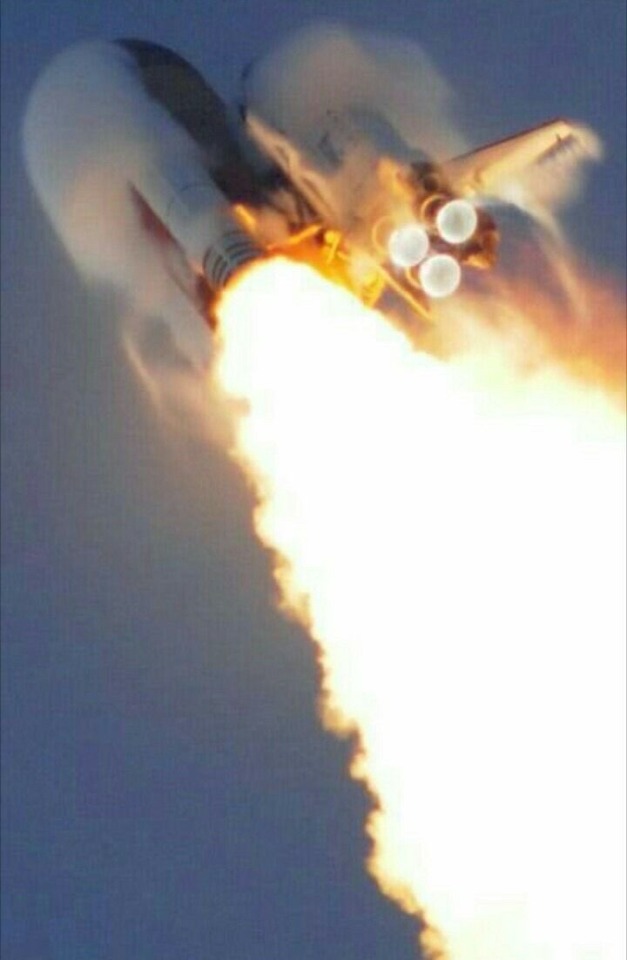
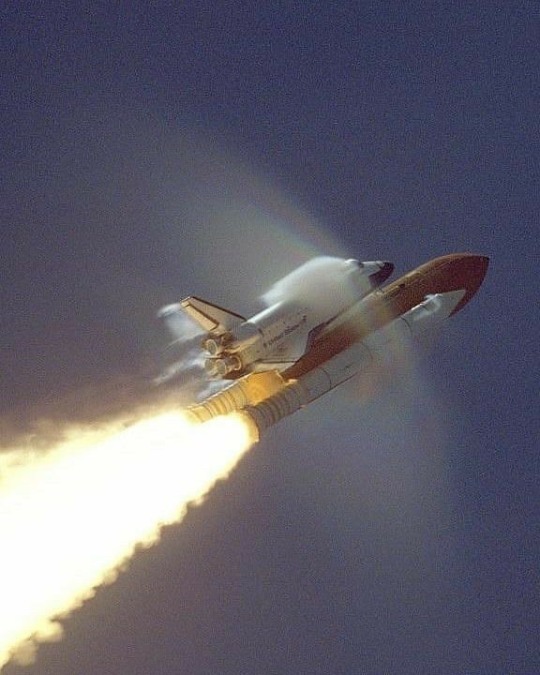
On January 28, 1986, the Space Shuttle Challenger broke apart 73 seconds into its flight, killing all seven crew members aboard. The spacecraft disintegrated 46,000 feet above the Atlantic Ocean, off the coast of Cape Canaveral, Florida, at 11:39 a.m. EST. A major malfunction 73 seconds after liftoff resulted in the loss of Challenger and the seven astronauts aboard. An agency investigation later showed unexpectedly cold temperatures affected the integrity of O-ring seals in the solid rocket booster segment joints. The launch was scheduled as the agency’s 25th shuttle mission. While the spacecraft waited overnight on Launch Pad 39B at NASA’s Kennedy Space Center in Florida, a cold front brought freezing temperatures, causing ice to form on the shuttle. Despite concerns raised by some shuttle program employees, managers cleared the mission for launch, with liftoff occurring at 11:38 a.m.
I will be adding more photos and videos to this same post. Including never before seen photos.
#astronomy#nasa#astronomers#universe#astrophotography#nasa photos#nasawebb#astrophysics#outer space#hubble space telescope#astronomy photography#apollo#space shuttle#challenger#1986#rip#goddard space flight center#spaceporn#space station#space photography#space science#space exploration#space#james webb space technology#james webb space telescope#hubble#team rocket#our universe#nasa tv#galaxies
94 notes
·
View notes
Text

Tanks for the Lift - February 24th, 1996.
"Sixteen minutes after the liftoff of STS-29, the Space Shuttle Discovey's jettisoned External Tank (ET) is seen here, in a photograph by shuttle astronaut James P. Bagian, falling back towards Earth. The 154 foot long ET is the largest non-reusable component in the Shuttle system. After carrying over 500,000 gallons of liquid propellant to feed the shuttle's main engines during liftoff, its ultimate fate is to re-enter the atmosphere, break up and descend into a remote ocean area. The side of this ET shows a normal burn scar caused during the separation of one of the reusable solid rocket boosters."
48 notes
·
View notes
Text

facebook.com
Incredible Stuff - Thewani Dewmi.
The US standard railroad gauge (distance between the rails) is 4 feet, 8.5 inches. That's an exceedingly odd number. Why was that gauge used? Well, because that's the way they built them in England, and English engineers designed the first US railroads. Why did the English build them like that? Because the first rail lines were built by the same people who built the wagon tramways, and that's the gauge they used. So, why did 'they' use that gauge then? Because the people who built the tramways used the same jigs and tools that they had used for building wagons, which used that same wheel spacing. Why did the wagons have that particular odd wheel spacing? Well, if they tried to use any other spacing, the wagon wheels would break more often on some of the old, long distance roads in England . You see, that's the spacing of the wheel ruts. So who built those old rutted roads? Imperial Rome built the first long distance roads in Europe (including England ) for their legions. Those roads have been used ever since. And what about the ruts in the roads? Roman war chariots formed the initial ruts, which everyone else had to match or run the risk of destroying their wagon wheels. Since the chariots were made for Imperial Rome , they were all alike in the matter of wheel spacing. Therefore the United States standard railroad gauge of 4 feet, 8.5 inches is derived from the original specifications for an Imperial Roman war chariot. Bureaucracies live forever. So the next time you are handed a specification/procedure/process and wonder 'What horse's ass came up with this?', you may be exactly right. Imperial Roman army chariots were made just wide enough to accommodate the rear ends of two war horses. (Two horses' asses.) Now, the twist to the story: When you see a Space Shuttle sitting on its launch pad, there are two big booster rockets attached to the sides of the main fuel tank. These are solid rocket boosters, or SRBs. The SRBs are made by Thiokol at their factory in Utah . The engineers who designed the SRBs would have preferred to make them a bit fatter, but the SRBs had to be shipped by train from the factory to the launch site. The railroad line from the factory happens to run through a tunnel in the mountains, and the SRBs had to fit through that tunnel. The tunnel is slightly wider than the railroad track, and the railroad track, as you now know, is about as wide as two horses' behinds. So, a major Space Shuttle design feature, of what is arguably the world's most advanced transportation system, was determined over two thousand years ago by the width of a horse's ass. And you thought being a horse's ass wasn't important? Ancient horse's asses control almost everything. 😁😁

22 notes
·
View notes
Text
Ok so I have a question. Are calories a property of the object or a property of its interaction with our digestive system. If I can't get energy out of it does it have calories?
Take solid rocket booster fuel, for example. That has a ton of energy. But I can't access any of it. Does it have calories?
12 notes
·
View notes
Text

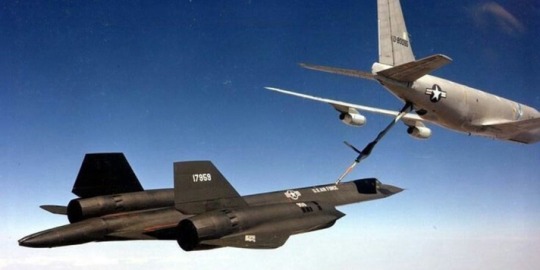
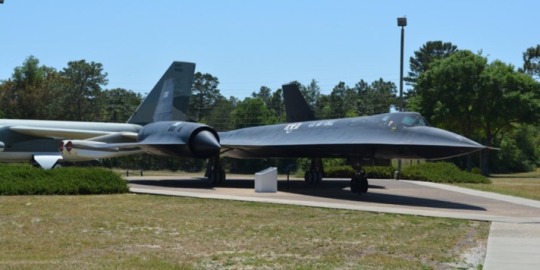

Big Tail SR-71
I thought it was ugly. It's like a bumblebee with too big of a stinger. Reading Paul Crickmore‘s book “Beyond the secret missions, the Missing Chapters. The real reason Big Tail wasn’t pursued further was the intercept capabilities of the SA-5 (4 solid-fueled strap-on rocket boosters launch the SA-5 Gammon missile) were less of a threat to the SR 71 than had been anticipated.
#959 came off the assembly line like any other SR-71 when rolled out on Aug. 16, 1965. It was chosen as the platform for a new set of sensor equipment to be carried in a nine-foot extension from the rear of the aircraft in 1975.
When the SRs went operational during the Vietnam War, some Missions were canceled due to weather conditions. This led to the experimental testing of the additional camera. In 1974, the Air Force identified a requirement for an aft-facing Electronic Countermeasures (ECM) capability for the SR-71, and several feasibility studies examined by the Air Force included conformal packages underneath the aft fuselage and belly pods, as well as an extended tail fairing. After researching all the possibilities, the extended tail appeared to be the most viable option based on the lowest cost, added volume, and least amount of aerodynamic drag.
The new ‘Big Tail’ assembly would be 13 feet 9 inches long and weigh 1,273 lbs. with 49 cubic feet of space to carry 864 lbs. of payload. The primary payload would consist of an aft-facing ECM and the 24-inch Optical Bar Camera. [According to Habu.org] because of the lengthened tail section, the new assembly would also have to be articulated to move 8.5 degrees upward to clear the runway during take-off and landing and then downward so it would not interfere with the aircraft’s drag chute deployment on rollout.
On Dec. 3, 1975, the “Big Tail” flew for the first time. The tests demonstrated little performance loss, but the new sensor equipment proved little advantage. The program was dropped, and this aircraft was last flown on Oct. 29, 1976, and is the only “Big Tail” in existence. Although Big Tail had proven to be a viable system operationally, the Air Force chose not to pursue the concept further. After only 36 flights with the extended tail, # 959 made its last flight on Oct. 29, 1976. You can find BIG TAIL at Eglin, Air Force Base, Florida.
Written by Linda Sheffield
@Habubrats71 via X
13 notes
·
View notes
Text
Science fact of the day- Solid Rocket Engines!
Solid rocket engines are the oldest type of rocket engines, and generally speaking the simplest. Their mechanics are fairly simple. The core of the motor is hollow, and it's surrounded by the rocket fuel, which is a solid mix of various chemicals, mostly aluminum perchlorate, with extra aluminum and some binding agents holding it together. As the solid fuel burns, it produces heat and very high pressure, and all that pressure is directed out the bottom of the engine at over a thousand meters per second! Solid rocket engines have a number of advantages. For one, because they've been used for a really long time, they're quite reliable, and because they're relatively simple that helps too. It also helps reduce the cost of building them, so they're not too expensive to build. Finally, they're just really damn powerful. All the most powerful engines ever made are solid rocket engines- most notably, the massive boosters of the Space Shuttle and Space Launch System.
However they have a few downsides too. For one, they can't be controlled at all once they're turned on. You can't actively throttle them once they're on (although the shape of the fuel can change over time to do it, but that has to be done months before launch), and theres only one way to full stop them once they're on. Which is. Explosion. Additionally, they're not very efficient. The way rockets work is through newton's third law- moving something fast one way moves something else the other way. The faster the things move go, the faster the other thing goes. In rockets, this means that the faster fuel goes out the back, the more thrust the rocket gets for the same amount of fuel- thus, efficiency is judged in exhaust velocity. High end Solid rocket engines (ie those on the space shuttle) get exhaust velocities of 2 km/s to 2.5 km/s, which sounds incredibly fast, but considering orbital velocity of the earth is nearly 8 km/s, it's not actually that much.
Because of the various benefits and downsides, solid rocket boosters have generally fallen into one specific niche- boosters. The idea is to have very efficient main engines to get the vehicle to orbit, but those engines are generally less powerful, and so the rocket will take of using Solid Rocket Boosters (SRBs) to get off the ground. Theyll burn for a couple minutes, and get the rocket high enough up so that it's less powerful but more efficient engines have time to push the rocket into a full orbit.
17 notes
·
View notes
Text
Rockets, Racecars, and the Physics of Going Fast

When our Space Launch System (SLS) rocket launches the Artemis missions to the Moon, it can have a top speed of more than six miles per second. Rockets and racecars are designed with speed in mind to accomplish their missions—but there’s more to speed than just engines and fuel. Learn more about the physics of going fast:

Take a look under the hood, so to speak, of our SLS mega Moon rocket and you’ll find that each of its four RS-25 engines have high-pressure turbopumps that generate a combined 94,400 horsepower per engine. All that horsepower creates more than 2 million pounds of thrust to help launch our four Artemis astronauts inside the Orion spacecraft beyond Earth orbit and onward to the Moon. How does that horsepower compare to a racecar? World champion racecars can generate more than 1,000 horsepower as they speed around the track.

As these vehicles start their engines, a series of special machinery is moving and grooving inside those engines. Turbo engines in racecars work at up to 15,000 rotations per minute, aka rpm. The turbopumps on the RS-25 engines rotate at a staggering 37,000 rpm. SLS’s RS-25 engines will burn for approximately eight minutes, while racecar engines generally run for 1 ½-3 hours during a race.

To use that power effectively, both rockets and racecars are designed to slice through the air as efficiently as possible.
While rockets want to eliminate as much drag as possible, racecars carefully use the air they’re slicing through to keep them pinned to the track and speed around corners faster. This phenomenon is called downforce.

Steering these mighty machines is a delicate process that involves complex mechanics.
Most racecars use a rack-and-pinion system to convert the turn of a steering wheel to precisely point the front tires in the right direction. While SLS doesn’t have a steering wheel, its powerful engines and solid rocket boosters do have nozzles that gimbal, or move, to better direct the force of the thrust during launch and flight.

Racecar drivers and astronauts are laser focused, keeping their sights set on the destination. Pit crews and launch control teams both analyze data from numerous sensors and computers to guide them to the finish line. In the case of our mighty SLS rocket, its 212-foot-tall core stage has nearly 1,000 sensors to help fly, track, and guide the rocket on the right trajectory and at the right speed. That same data is relayed to launch teams on the ground in real time. Like SLS, world-champion racecars use hundreds of sensors to help drivers and teams manage the race and perform at peak levels.

Knowing how to best use, manage, and battle the physics of going fast, is critical in that final lap. You can learn more about rockets and racecars here.
Make sure to follow us on Tumblr for your regular dose of space!
#NASA#Artemis#Moon#Space Launch System#rocket science#space#exploration#Moon 2024#rocket testing#racecar#tech#technology#motorsport
1K notes
·
View notes
Text
STS-1: mating Columbia with the External Tank and Solid Rocket Boosters

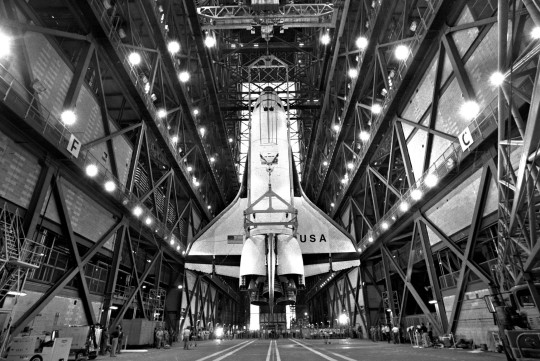


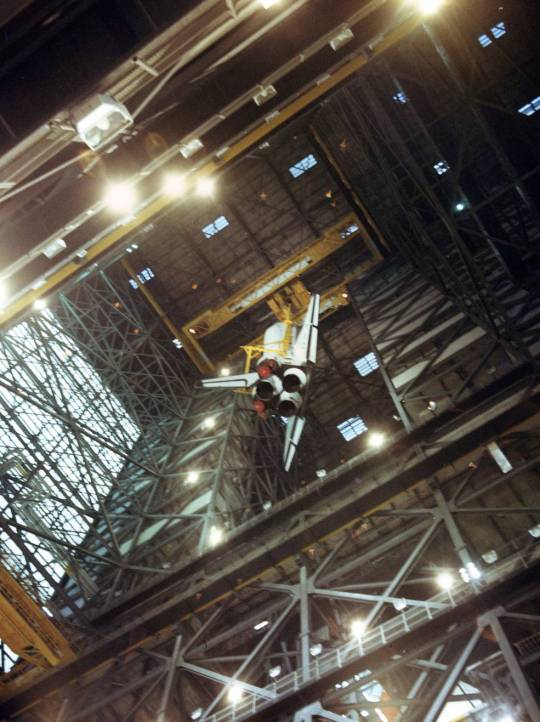

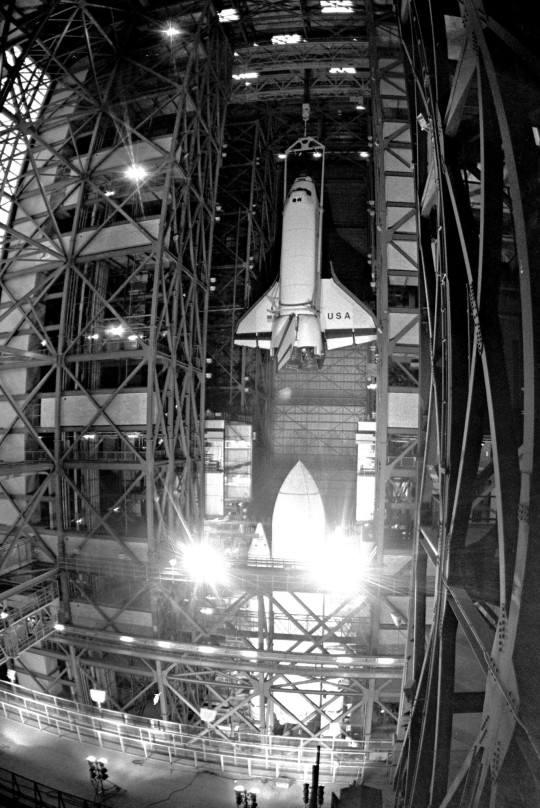
"Workers grappled Columbia with a crane and lifted it from the transfer aisle, hoisting it more than 190 feet in the air to transfer it to High Bay 3 before lowering again to join it to the already assembled ET and SRBs.
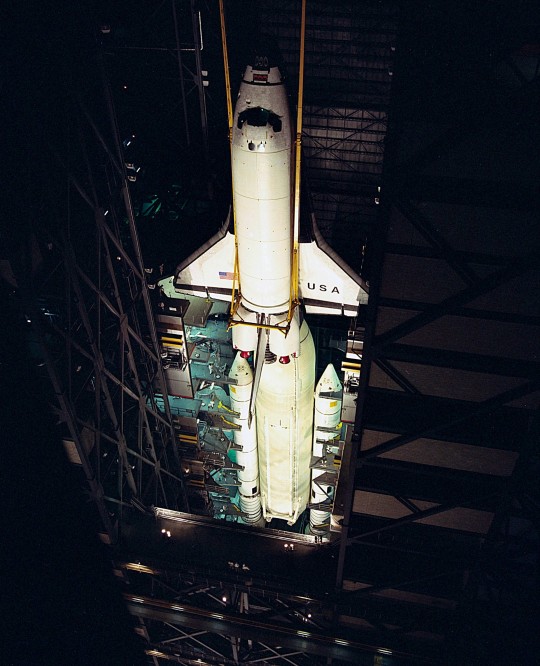

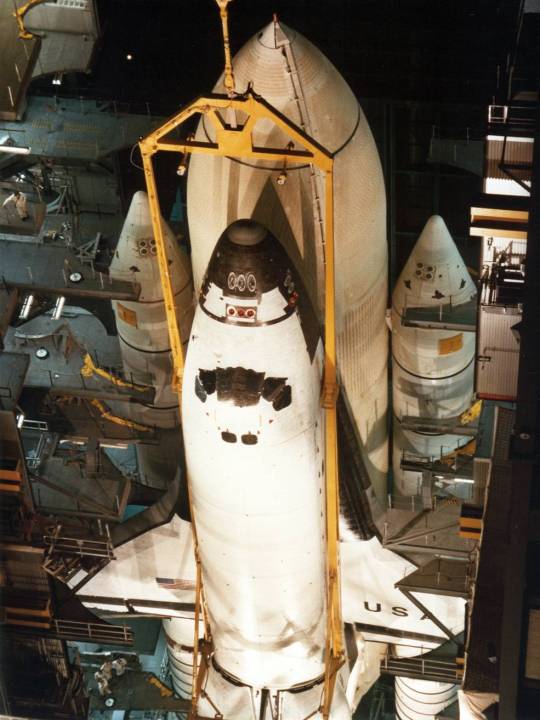
By early Nov. 26, workers completed all the connections to Columbia as engineers activated the orbiter to prepare the assembled vehicle for a series of tests. As part of the two-week shuttle interface test, on Dec. 4, engineers powered up the entire stack for the first time. Additional tests ensured that all systems operated as expected in the overall vehicle and ground systems."
Date: November 25, 1980
Space Shuttle Columbia preparing for completed assembly. 1980-11-24. State Archives of Florida, Florida Memory. Accessed 26 Jun. 2023.<https://www.floridamemory.com/items/show/8707>
NASA ID: KSC-80P-0284, 0523-80PC-618, 0534-80PC-0557, link, KSC-80P-0282, KSC-80PC-0558, S80-42883, KSC-80P-0292, S80-42881
#STS-1#Space Shuttle#Space Shuttle Columbia#Columbia#OV-102#Orbiter#NASA#Space Shuttle Program#stacking#Vehicle Assembly Building#VAB#Kennedy Space Center#KSC#Florida#November#1980#my post
197 notes
·
View notes
Photo

2022 November 19
Artemis 1 Moonshot
Image Credit & Copyright: John Kraus
Explanation: When the Artemis 1 mission's Orion spacecraft makes its November 21 powered flyby of the Moon, denizens of planet Earth will see the Moon in a waning crescent phase. The spacecraft will approach to within about 130 kilometers of the lunar surface on its way to a distant retrograde orbit some 70,000 kilometers beyond the Moon. But the Moon was at last quarter for the November 16 launch and near the horizon in the dark early hours after midnight. It's captured here in skies over Kennedy Space Center along with the SLS rocket engines and solid rocket boosters lofting the uncrewed Orion to space. Ragged fringes appearing along the bright edge of the sunlit lunar nearside are caused as pressure waves generated by the rocket's passage change the index of refraction along the camera's line of sight.
∞ Source: apod.nasa.gov/apod/ap221119.html
89 notes
·
View notes
Note
for the tag game Put in the work 👀
Former nasa au my beloved <333
When I first thought this up, I thought Harley working at NASA would be the main setting of the story, but then I was like hE ShOuLD bE a sINgLe FaThER like this detail wouldn't disrupt the entire structure I had planned lmao
The first half goes back and forth between past (having his daughter, Hazel, working at NASA, meeting Spider-Man via twitter, etc.) and present (moving to NYC after getting laid off, trying to connect with teenage Hazel, and meeting Peter). Then the timeline syncs up and it's all in the present. Which worked out surprisingly well! I was worried about how to get in everything about Hazel and NASA without having to write another mammoth 100k+ story 😅
I'm SO CLOSE to finishing this. Most of the ending is already written, I just need to connect the scenes and clean them up. There are like... MAYBE 2 and a half scenes that still need to be written. MAYBE. It's mostly transitions.
Unfortunately my dumb brain is like,,,, close enough! Let's call it a day gentlemen.
Anyway, have an excerpt!
Ten Years Old
Frozen on the couch, Harley watches the television in horror as Spider-Man prances all over the launchpad and the rocket Harley spent the past several years painstakingly designing, constructing, and testing. He worked his ass off just to get his designs on the board.
His ideas. His rocket.
“I’ll kill him.”
“Don’t worry, daddy. Spidey’s gonna lock him up.”
Hazel is standing on the cushion beside him hopping from foot to foot, enraptured by the chase. He should make her leave the room in case something traumatizing happens, but he can’t look away, he can barely breathe as years of rigorous work teeter on the edge of destruction.
Spider-Man shoots a web onto one of the solid rocket boosters and Harley grits his teeth as he swings around and plants a foot in the face of some dude on a hoverboard wearing an obnoxious orange hazmat suit.
He looks like an Among Us character. Completely ridiculous. Not a threat. Certainly not worth risking his rocket.
“No, baby,” he says calmly, “I’m going to kill Spider-Man.”
“Dad!” Hazel whacks his shoulder. “He’s the good guy!”
“He’s going to ruin everything.”
Harley doesn’t care why a New York vigilante is in Florida. He doesn’t care what the bad guy’s beef is or what he was going to do.
If Spider-Man ruins his shot at space, he’s dead.
Long years of sacrificing his time to study, work, and attend class, the extra hours he put in every night after putting Hazel to bed to ensure he’d be good enough to be put on the rocket crew as a fresh-faced college graduate, the stress born from teetering on the edge of poverty—if anything happens to that rocket, it’s all up in smoke. Time he’ll never get back. All that effort, wasted.
The moment Spider-Man swung onto the launchpad chasing hoverboard guy, the big wigs in charge called off the launch. Now it’s a matter of waiting to see if his rocket will survive the encounter. If his rocket survives unscathed, they can reschedule, but if it gets so much as dinged, NASA is going to want to do a full inspection to make sure it’s still in perfect condition, and if it falls…
Well, if it falls Harley is going to have to do something extremely unpleasant to New York’s favorite web spinner.
The camera zooms out as Spider-Man springs away from something hoverboard guy threw. The something, a tiny black dot, smacks into the fin of Harley’s rocket. Then it detonates in a ball of fire and a burst of thick black smoke.
Hazel screams. The rocket tips. His heart stalls in his chest.
Then he’s on his feet, hands in his hair, and Hazel is yelling and jumping up and down on the couch, yanking on his arm as the rocket tips and tips and falls…
…and Spider-Man catches it.
There is a moment, a suspension in time, where Spider-Man holds an 8.5 million pound rocket over his head. A moment where Harley’s heart and lungs cease and everything goes still. He loses awareness of Hazel’s nails clawing into his arm and her voice, shrill and vibrant, in his ear.
For a moment, there is only Spider-Man, the dark smoke billowing around his calves, and the rocket held over his head. Two RS-25 engines rest on the ground and the rest of the build towers over him, tiny as a bug below it, and he holds it.
Then the launch vehicle stage adapter breaks loose and the entire top half of the rocket cracks off and hits the ground with enough force to shake the camera. It cracks like an egg.
Harley buries his face in his hands and sinks into the couch with a miserable moan. The TV drones on while a small hand rubs comforting circles on his back, but he can’t watch anymore.
“He got him, daddy,” Hazel says less than a minute after Harley’s rocket shattered without ever getting the chance to fly. “Spidey caught the bad guy.”
Yippee.
#parkner#ask games#sharing excerpts from this fic is such a challenge#there are several twitter and text exchanges that i just can't format on tumblr *profound sigh* oh well#anyway i love this fic with my whole heart#sure would like to finish it someday#put in the work#sswrites
57 notes
·
View notes